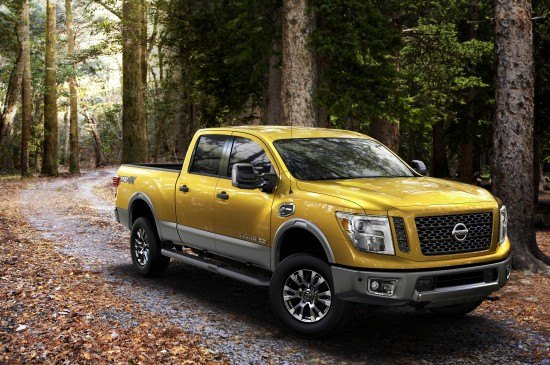Question Of The Day: Can Nissan Sell 100,000 Titans Annually?
In the nameplate’s best-ever year, Nissan sold 86,945 Titans in the United States.
Nissan USA wants to sell 100,000 Titans annually when the new model, with its more extensive lineup, arrives for the 2016 model year.
• Titan sales declined 20% in 2014
• Titan volume peaked at 87K in 2005
• F-Series, GM, Ram combined for 1.9M full-size truck sales in 2014
A 15% uptick from that record-setting year – the Titan’s second full year in the U.S., 2005 – doesn’t sound like an insurmountable leap forward. But an increase to 100,000 units would represent a six-fold improvement over the Titan’s U.S. sales average from the last three years.
According to Automotive News, Nissan North America’s chairman, Jose Munoz, told a crowd at the J.D. Power Automotive Summit that their aspirations are “modest,” and that when it comes to the automaker’s expectations for the Titan, “We’re very bullish.”
But is it reasonable to expect that the Titan could penetrate the market with Toyota Tundra-like force?
With 118,493 sales in 2014, Toyota USA reported their best Tundra sales year since 2008 and earned 5.7% market share in the full-size category. Nissan feels that less than 5% market share in the full-size category, “would be considered by us as not very successful.”
In other words, Nissan needs to sell Titans at a record-setting pace even though the market for full-size trucks, at least in 2014, was down 16% compared with 2005, when Titan volume was at its previous best.
To earn 5% market share in the full-size truck category in 2014, Nissan would have needed to sell 103,000 Titans. Nissan sold 12,527 Titans in 2014.
Recent performances may mean very little aside from the fact that, without so much as a facelift or new powertrain, the first-gen Titan became something of a laughingstock in the truck world. In 2004, Nissan was marketing a 305-horsepower, 5.6L V8-powered truck with a 5-speed automatic and an EPA-rated 17 mpg on the highway at a time when Ford was offering a 231-horsepower, 4.6L V8, a 4-speed automatic, and 17 mpg on the highway. Fair enough.
A decade later, however, Nissan was still selling the same truck (albeit with 12 more ponies), but it was up against gas-fired six and eight-cylinder pickups from Ram with EPA highway ratings between 21 and 23 miles per gallon, 305 or 395 horsepower, and 8-speed automatics. The lack of redevelopment may not have done the Titan nameplate any favours, particularly not in a category where hundreds of thousands of buyers have already attached their loyalty to top-selling trucks.
But the new Titan is most definitely new. There will be an available Cummins diesel, a semi-heavy-duty XD version with a unique frame, and more available configurations across the board. Nissan will therefore be tackling a far larger portion of the pickup market. But will they do so with as much success as they anticipate and apparently require?
Here’s a scenario full of assumptions that would work in the new Titan’s favour. The full-size truck market grows 8% in 2015, just as it did in 2014, and then does so again in 2016, when the Titan is readily available. Now the full-size market is nearly the same size as it was in 2005, when the Titan performed at its best. With 2.41 million sales to split and Nissan needing 100,000 units (equal to 4.1% market share), the competitors must only generate 2.31 million sales. ( They generated 2,053,721 sales in 2014.) This would mean that the F-Series, Silverado, Sierra, Ram, and Tundra collectively rose 12.5% over the course of two years, a healthy boost to their own volume which would still, in turn, create space for bigger Titan numbers, too.
In other words, growth in the overall truck market would allow the Titan to expand its volume without needing to steal sales from the established players, something it didn’t need to do in its 2004 debut year, either. That year, full-size sales jumped by 177,000 units, or 8%, and Nissan added more than 80,000 of those sales.
And if the full-size truck market doesn’t grow? If plans for growth are stalled by the shocking success of a revitalized small/midsize truck segment? If there is substantial growth but consumers don’t take kindly to the Titan’s new face? If Nissan is taken aback by Detroit’s willingness to incentivize their trucks at all cost to avoid losing market share? In those cases, all bets are off.
Timothy Cain is the founder of GoodCarBadCar.net, which obsesses over the free and frequent publication of U.S. and Canadian auto sales figures.
More by Timothy Cain
Latest Car Reviews
Read moreLatest Product Reviews
Read moreRecent Comments
- Slavuta Nissan + profitability = cheap crap
- ToolGuy Why would they change the grille?
- Oberkanone Nissan proved it can skillfully put new frosting on an old cake with Frontier and Z. Yet, Nissan dealers are so broken they are not good at selling the Frontier. Z production is so minimal I've yet to see one. Could Nissan boost sales? Sure. I've heard Nissan plans to regain share at the low end of the market. Kicks, Versa and lower priced trims of their mainstream SUV's. I just don't see dealerships being motivated to support this effort. Nissan is just about as exciting and compelling as a CVT.
- ToolGuy Anyone who knows, is this the (preliminary) work of the Ford Skunk Works?
- Kwik_Shift_Pro4X I will drive my Frontier into the ground, but for a daily, I'd go with a perfectly fine Versa SR or Mazda3.





































Comments
Join the conversation
They will sell maybe 50K the first year and by the time it is 5 years old it will back under 20K per year unless they do big discounts and I mean really big discounts.
I am much more interested in what they do with the Frontier.